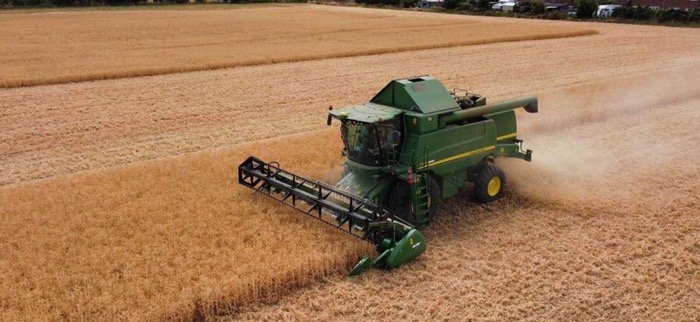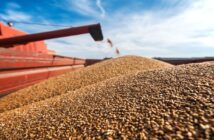The US wheat market has remained virtually unchanged week on week as inflationary demand concerns offset a bullish USDA US wheat outlook, and the longevity of the Ukrainian grain export corridor. Also USDA has trimmed US 2022 wheat production by 3.5m tonnes in its latest report reflecting declines in both harvested area and yield.
After a slow start, Russian wheat exports are now seen at a record 43.4m tonnes according to SovEcon, citing a growing harvest and rising import demand as the rationale for the upgrade. Despite this, Russia may start providing trade finance to importers as an additional means to offset sanctions which continue to slow the pace of exports.
As expected, Ukraine’s grain exports so far this marketing year have fallen to about 8.6m tonnes, down 40% year on year. Shipments so far include 4.8m tonnes of corn, 3m tonnes of wheat and 750,000t of barley.
With an expected 70m tonnes harvest, Ukrainian storage capacity is again raising concerns with the government ‘hoping for a prolongation of the mandate to bring grain out of Ukrainian ports’.
Ukrainian farmers had planted 1.2m tonnes of winter grains as of 3 October, including 1.1m ha of wheat which is 27% of the total planned area.
Currency fluctuations continue to influence markets this week. sterling has strengthened against the dollar, following Liz Truss’ u-turn earlier in the weekclosing at £1=$1.473, levels last seen before her ‘mini budget’ announcement. This was the sixth consecutive rise and added pressure to domestic wheat markets.
The US dollar then eased against other currencies, following a fall in the US treasury yields. Furthermore, the pound continued to strengthen following the U-turn. The dollar has since strengthened, while sterling weakened in anticipation of the PM’s conference speech.
It is likely that volatility in sterling will continue following the outcomes of the Conservative Party conference. However, the Office for Budget Responsibility is due to deliver its initial forecasts to government on 7 October for the government’s fiscal plan. This may provide some certainty for markets on delivery.
War driving factor
The conflict between Russia and Ukraine remains a key factor driving grain and oilseed prices, continuing to provide underlying support to markets, according to Tom Price of AHDB.
“Global trade dynamics have been impacted as a result, with the flow of grains and oilseeds leaving Ukraine initially restricted. Though an export deal was established in July. The Istanbul Agreement allows exports from the Black Sea grain corridor for 120 days from 22 July until the end of November.
“Since the establishment of this deal, the flow of exports has been gaining strength. According to UkrAgroConsult, agricultural exports from 1-18 September totalled 3.9m tonnes. Of this, 2.0m tonnes left Odessa (including maize, wheat, rapeseed, and vegetable oils). Total September exports of agricultural goods may even reach record levels of 5.5 – 6.0m tonnes. If realised, this could be over the previous September 2019 record of 5.8m tonnes (according to UkrAgroConsult).”
For total exports (including rail and road), the UkrAgroConsult report that 784.8000 tonnes of rapeseed had been exported in July and August. This is only 5.9% behind last season (July to August).
According to the United Nations, as at 27 September, 399.6000 tonnes of rapeseed had left Ukraine by port (from Odessa, Chornomorsk, Yuzhny/Pivdennyi). This was recorded to The Netherlands, France, Romania, Belgium, Germany, and Portugal.
Mr Price added, “According to European Commission customs surveillance data, as of 25 September, a total of 809.2Kt of rapeseed had been imported to the EU from Ukraine (as total movement) so far this marketing year (2022/23). This accounts for over half of all EU imports of rapeseed for 2022/23 season to date. If realised, these numbers confirm a continued flow of rapeseed exports into the EU. And as we have seen in UK figures to date, some EU rapeseed continues to move into the UK (albeit lower than last season).
“Ukrainian rapeseed imports, over the last 3 full seasons, accounted for an average of 31.5% of total UK rapeseed imports and therefore are significant to follow. We can see that Ukrainian rapeseed exports continue to the EU, and some imports continue to flow from the EU into the UK. Though no direct movements from Ukraine have been seen in UN data yet.”
The situation in Ukraine continues to be watched closely, following the referendums in occupied Ukraine and the calling up of Russian reserves. The established grain corridor will be key to continue the flow of rapeseed leaving Ukraine, and therefore rapeseed available on the continent. If we see this squeezed, we could see rapeseed prices supported in the EU and UK.
Though other factors too will be key to watch going forward for UK imports of rapeseed, including exchange rates making imports more expensive, and demand considering recessionary concerns.




